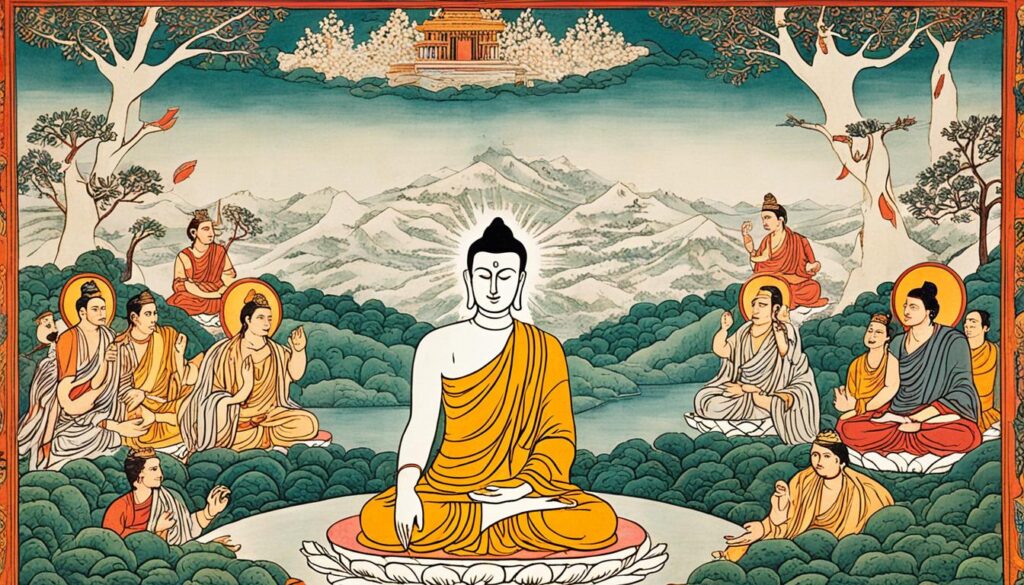Did you know that Buddhism was India’s dominant religion in 100 BCE? It may come as a surprise, considering the prevalent understanding of India’s religious landscape. In this article, we will explore the fascinating history of Buddhism in ancient India and its subsequent development and spread. From its origins with Siddhartha Gautama to its revival in modern times, Buddhism’s journey offers insights into the complex tapestry of Indian history and the enduring appeal of this ancient faith.
Key Takeaways:
- Buddhism was the dominant religion in ancient India around 100 BCE.
- Siddhartha Gautama, also known as the Buddha, founded Buddhism.
- The practice of Buddhism declined in India after the collapse of the Gupta Empire.
- Buddhism has experienced a revival in India in recent times.
- Buddhism’s teachings revolve around achieving enlightenment and inner peace.
Core Beliefs and Practices of Buddhism
Buddhism is a non-theistic faith that focuses on achieving enlightenment and inner peace. Followers of Buddhism don’t acknowledge a supreme god or deity but instead practice morality, meditation, and wisdom. The core beliefs and practices of Buddhism revolve around key principles that guide individuals towards ending suffering and achieving liberation.
The Four Noble Truths
The Four Noble Truths are fundamental teachings in Buddhism that reveal the nature of suffering and provide a path to overcome it. They are:
- Dukkha – the truth of suffering: The recognition that suffering is an inherent part of human existence.
- Samudaya – the truth of the origin of suffering: The understanding that attachment and desire lead to suffering.
- Nirodha – the truth of the cessation of suffering: The realization that it is possible to end suffering by eliminating attachment and desire.
- Magga – the truth of the path to the cessation of suffering: The Eightfold Path, which provides guidelines for living a virtuous and enlightened life.
The Eightfold Path
The Eightfold Path is a set of ethical guidelines, meditation practices, and mental disciplines that help individuals achieve enlightenment. It consists of:
- Right View: Developing an understanding of the nature of reality and the principles of Buddhism.
- Right Intention: Cultivating intentions of goodwill, compassion, and non-harm towards oneself and others.
- Right Speech: Practicing truthful, kind, and beneficial communication.
- Right Action: Engaging in ethical conduct, refraining from harming oneself and others.
- Right Livelihood: Choosing a livelihood that aligns with Buddhist principles, avoiding occupations that harm others.
- Right Effort: Cultivating effort to develop positive qualities and overcome negative tendencies.
- Right Mindfulness: Developing present-moment awareness and mindfulness in all activities.
- Right Concentration: Cultivating focused and tranquil states of mind through meditation.

Karma, Reincarnation, and Nirvana
Central to Buddhist philosophy is the belief in karma, the law of cause and effect. Buddhists believe that one’s actions, thoughts, and intentions have consequences, shaping their future experiences. Reincarnation, or the continuous cycle of rebirth, is another concept in Buddhism. It is believed that individuals are reborn based on their accumulated karma. The ultimate goal of Buddhism is to attain enlightenment and liberation from the cycle of rebirth. This state of liberation is known as nirvana, a state of perfect peace, wisdom, and liberation from suffering.
| Buddhist Beliefs and Practices | Description |
|---|---|
| Moral Code | Buddhists adhere to a moral code based on principles of non-harming, compassion, and ethical conduct. |
| Buddhist Teachings | Buddhist teachings provide guidance on living a virtuous life, cultivating mindfulness, and understanding the nature of reality. |
| Meditation | Meditation is a central practice in Buddhism, helping individuals develop concentration, mindfulness, and insight. |
The Life and Teachings of Siddhartha Gautama
Siddhartha Gautama, also known as the Buddha, was the founder of Buddhism in the 5th century BCE. Born into a wealthy family in present-day Nepal, Siddhartha lived a privileged and comfortable life. However, his existence took a transformative turn when he encountered the harsh realities of suffering and realized the impermanence of worldly pleasures.
Determined to find a solution to alleviate human suffering, Siddhartha renounced his opulent lifestyle and embarked on a profound spiritual journey. He sought enlightenment, a state of ultimate wisdom and liberation from the cycle of birth and death.
After years of rigorous self-discipline and meditation, Siddhartha attained enlightenment under a Bodhi tree, in what is now Bodh Gaya, India. This awakening marked a pivotal moment in his life, and he became known as the Buddha, meaning “the enlightened one.”
The teachings of the Buddha revolve around the concept of the Middle Way, a path that encourages a balanced and moderate approach to life, avoiding extremes of indulgence or asceticism. The Middle Way advocates for living a virtuous and ethical life while cultivating mindfulness and wisdom.
Throughout his life, the Buddha dedicated himself to teaching and guiding others on their spiritual paths. He emphasized the importance of understanding the true nature of suffering, the causes of suffering, and the path to liberation from suffering. The Buddha’s teachings provide profound insights into the nature of existence, the human mind, and the pursuit of enlightenment.
The life and teachings of Siddhartha Gautama, the Buddha, continue to inspire and guide millions of people around the world on their own spiritual journeys towards inner peace and enlightenment.

The Spread and Development of Buddhism
In the 3rd century BCE, Buddhism began to spread beyond the borders of India, thanks to the efforts of Emperor Ashoka the Great during the Mauryan Empire. Ashoka, who had a profound conversion to Buddhism, played a crucial role in the dissemination and establishment of the faith. He not only made Buddhism the state religion but also supported the construction of monasteries and the organization of missionary work to promote the spread of Buddhism to various regions.
The Buddhist councils were instrumental in ensuring the preservation and transmission of Buddhist teachings. The councils, consisting of a gathering of monks, were convened to discuss matters related to the Buddha’s teachings, clarify doctrines, and resolve disputes. The First Buddhist Council, held shortly after the Buddha’s death, aimed to recite and compile his teachings. The Second Buddhist Council, however, marked the first official schism within the Buddhist community.
The Second Buddhist Council, held around 387 BCE, resulted in the formation of different early Buddhist schools, each with its own interpretations and views. Two main schools emerged from this schism: the Sthaviravada (Theravada) and the Mahasanghika (Mahayana). These early Buddhist schools laid the foundation for the diversity and development of Buddhism.
Over time, Buddhism diversified into various branches, each with its unique texts, practices, and interpretations of the Buddha’s teachings. Some of the well-known branches of Buddhism include:
- Theravada Buddhism: Emphasizes the original teachings of the Buddha and focuses on individual liberation through meditation and virtuous living.
- Mahayana Buddhism: Known as the “Great Vehicle,” it emphasizes compassion and the idea of the bodhisattva, one who seeks to attain enlightenment to benefit all sentient beings.
- Tibetan Buddhism: Developed in Tibet, it incorporates elements of Mahayana Buddhism and unique practices, rituals, and teachings from Tibetan culture.
- Zen Buddhism: Known for its emphasis on meditation and direct experience to attain enlightenment. Zen Buddhism has had a significant influence on Japanese culture and arts.
This diversity within Buddhism reflects the richness and adaptability of the teachings, allowing practitioners to choose the path that resonates with them the most.

| Branch of Buddhism | Key Characteristics |
|---|---|
| Theravada Buddhism | Focuses on individual liberation through meditation and virtuous living |
| Mahayana Buddhism | Emphasizes compassion, the idea of the bodhisattva, and achieving enlightenment for the benefit of all sentient beings |
| Tibetan Buddhism | Incorporates Mahayana Buddhism with unique Tibetan practices, rituals, and teachings |
| Zen Buddhism | Emphasizes meditation and direct experience to attain enlightenment, heavily influencing Japanese culture and arts |
Conclusion
Buddhism has left an indelible mark on the world, particularly in East and Southeast Asia. Its teachings on mindfulness, compassion, and the pursuit of enlightenment provide invaluable insights for personal and societal transformation. As Buddhism continues to adapt and evolve in different cultural contexts, its influence is steadily growing in the West as well.
The principles and values of Buddhism resonate deeply with individuals seeking spiritual growth and inner peace. By encouraging awareness of the present moment and cultivating compassion for oneself and others, Buddhism offers a path to harmony and fulfillment. Its emphasis on understanding and alleviating suffering has a profound impact on the lives of its followers.
From its roots as the dominant religion in ancient India during 100 BCE to its subsequent development and spread throughout the world, Buddhism remains relevant and meaningful in the modern era. Its enduring appeal lies in its universal teachings, which address the fundamental questions of human existence.
The significance of Buddhism extends beyond its historical and cultural impact. It continues to inspire millions of people to lead more intentional and compassionate lives, fostering a sense of interconnectedness and empathy. In an ever-changing world, Buddhism’s wisdom and teachings offer solace and guidance, reminding us of the importance of inner reflection and harmony with the world around us.
FAQ
Was Buddhism the dominant religion in ancient India?
Yes, Buddhism was India’s dominant religion in 100 BCE.
Who founded Buddhism?
Buddhism was founded by Siddhartha Gautama, also known as the Buddha.
What are the core beliefs and practices of Buddhism?
Buddhism focuses on achieving enlightenment and inner peace through morality, meditation, and wisdom. The Four Noble Truths and the Eightfold Path are fundamental teachings that guide followers towards ending suffering and achieving liberation.
What is the significance of Siddhartha Gautama in Buddhism?
Siddhartha Gautama, or the Buddha, renounced his lavish lifestyle and attained enlightenment. He spent the rest of his life teaching others about his experiences and guiding them towards enlightenment.
How did Buddhism spread beyond India?
Buddhism spread during the reign of Ashoka the Great in the Mauryan Empire. Ashoka made Buddhism the state religion and supported its spread through the building of monasteries and the organization of councils.
How did Buddhism diversify over time?
Buddhism diversified into different schools such as Theravada, Mahayana, Tibetan, and Zen Buddhism, each with its own specific texts, practices, and interpretations of Buddha’s teachings.
What is the impact of Buddhism in the world?
Buddhism has had a significant impact, particularly in East and Southeast Asia, offering insights for personal and societal transformation. Its principles of mindfulness, compassion, and seeking enlightenment resonate with individuals seeking spiritual growth and harmony.

